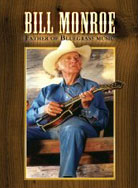August 2008
A particularly significant moment, artfully downplayed, shows Paul McCartney, well into post-Beatles days, performing Monroe’s song "Blue Moon of Kentucky," which Elvis Presley made famous. This illustrates a key theme: Monroe’s work has remade Western culture, not just in lots of people’s liking his work, but via a specific, concrete chain of influence culminating in the Louvin Brothers, the Everly Brothers, and the Beatles. Jerry Garcia is interviewed on the DVD and holds forth on Monroe’s importance, as do many other music luminaries -- some of whom performed and recorded with Monroe back in the day, some later, some never. In addition to getting those historic aspects across through dedicated research and archival footage, the DVD wouldn’t be complete without lots of just plain fine music. It delivers -- with the same kind of proportionality that gives the interviews and documentation so much impact. Not just anyone who can write a song or bang out some chords makes it in bluegrass. You have to master your instrument, sing exceptionally well, or do both. We see this in a constellation of stars of then and now. We get consistently good visuals and sound, considering the obstacles inherent in the vintage of some material. Bill Monroe: Father of Bluegrass Music should help liberate many minds, including aspiring artists’, in a commerce-dominated world that consistently overvalues what’s new by obscuring how art emerges and evolves. GO BACK TO: |
 Bill Monroe - Father of
Bluegrass Music
Bill Monroe - Father of
Bluegrass Music